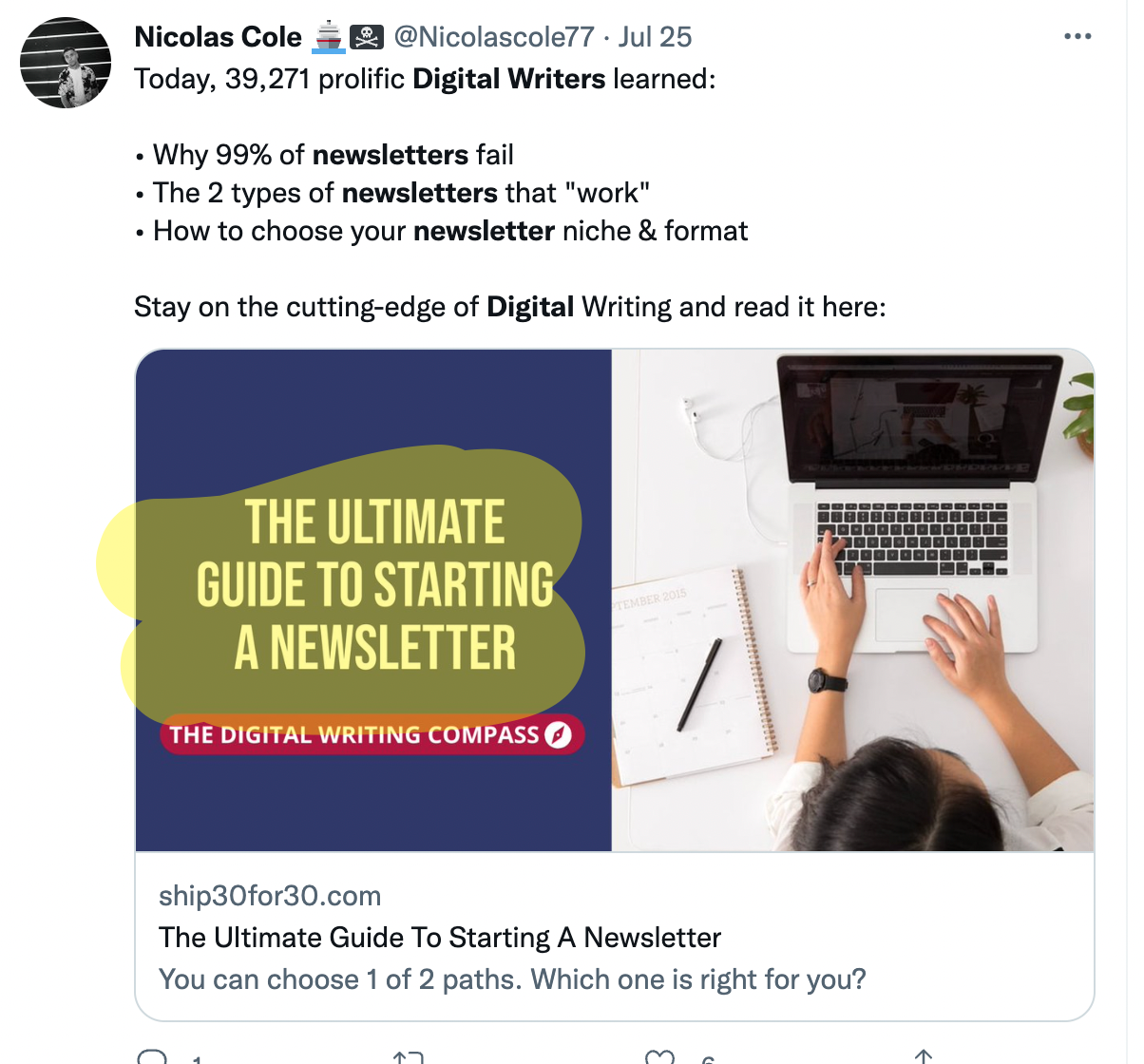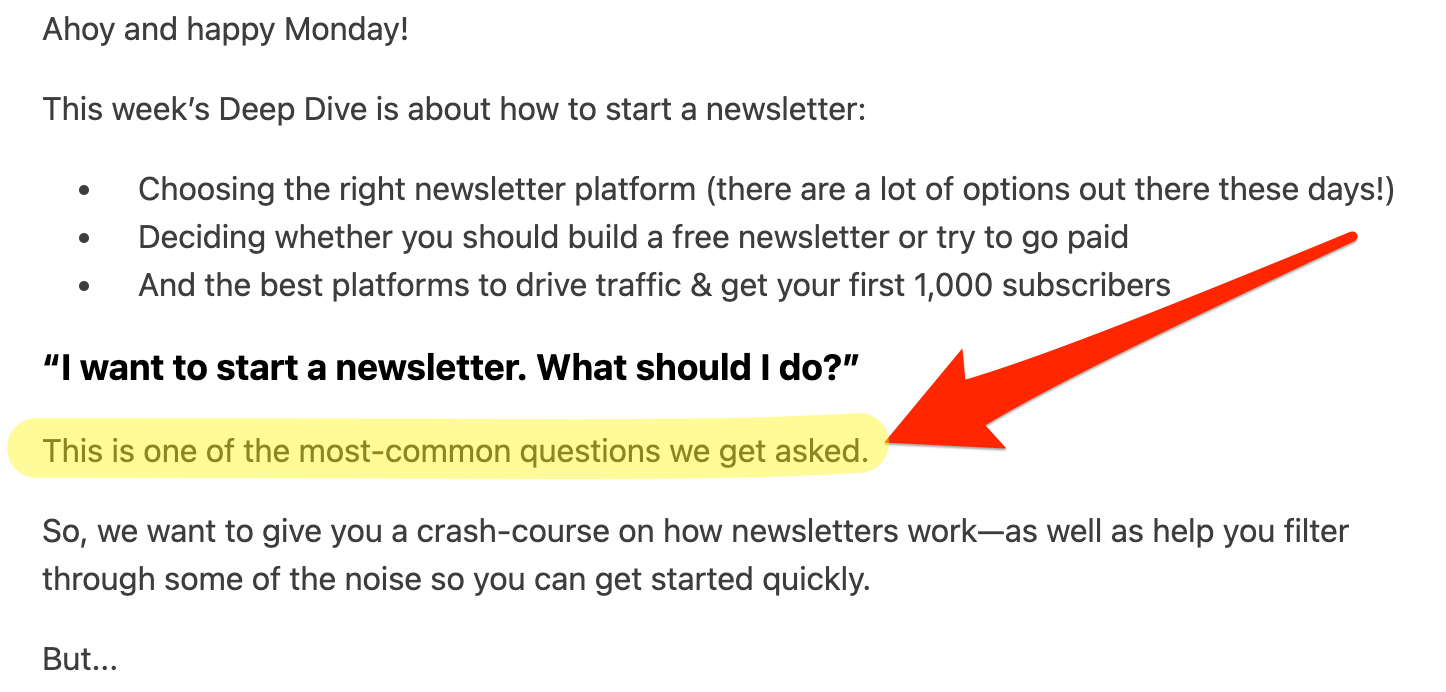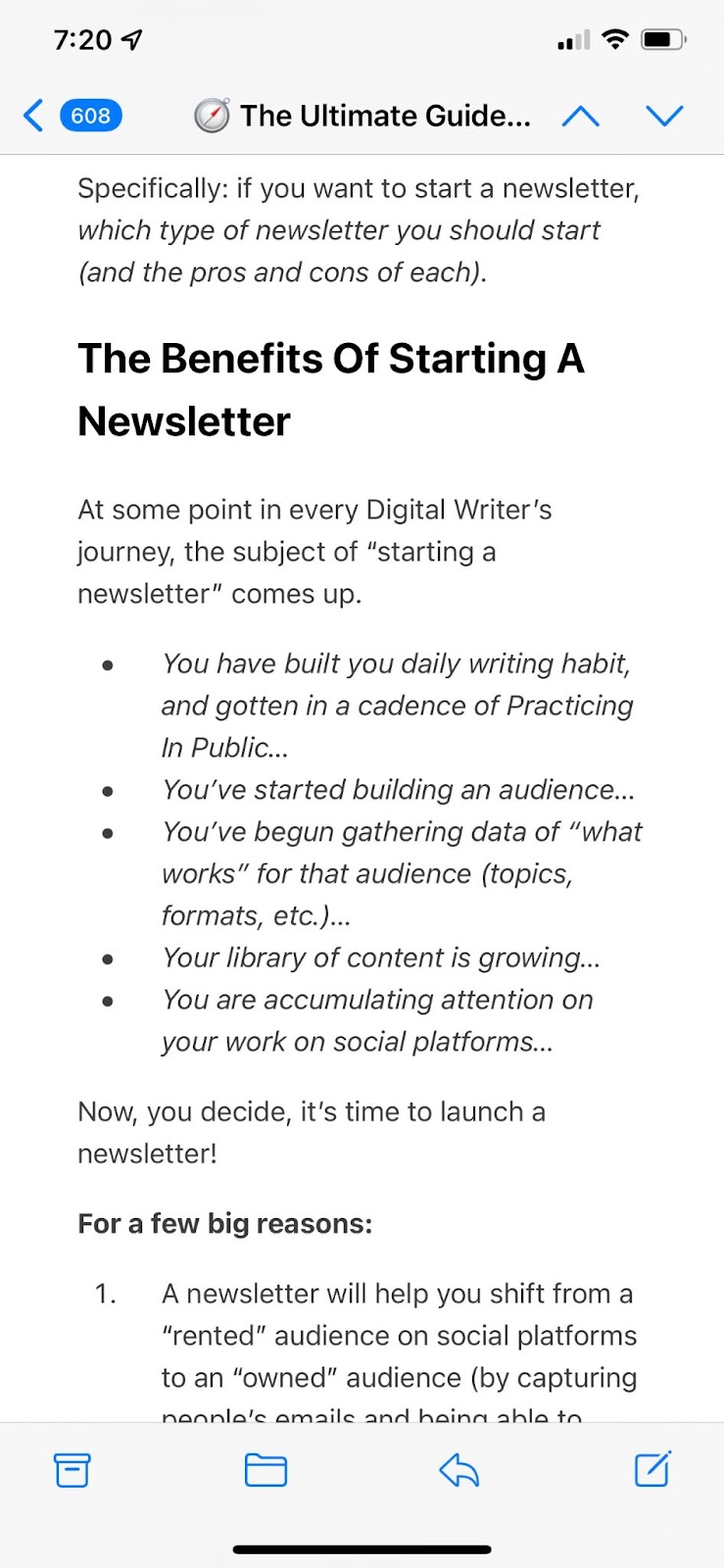In this week's Digital Writing Compass Deep Dive, we want to give you five simple tips for formatting a newsletter that your readers will look forward to reading every week.
But first, let’s talk about reader UX 101.
Before a reader dives into your newsletter, they skim it.
The reader needs to SEE your newsletter before they decide whether it is worth reading in detail. If you present the reader with a wall of text, 3 call to action buttons, and a sea of green in the background, the reader is going to mash the red x faster than a spooked fish.
Don’t do this.👇

Great formatting hooks readers and keeps their eyes moving down the page.
- The reader should be able to skim the subject line and "get it."
- And then skim the subheads all the way to the end and "get it."
- And then skim the first sentence of any given section and "get it."
Got it?
Your newsletter could be amazing, but if you skimp on the formatting, nobody is going to read it. And whether your newsletter is short and curated or long and original, Digital Writing fundamentals apply.
Let’s get into it!
Tip #1: Start with a clear subject line.
Your email newsletter subject is your headline. Period.
On the internet of common wisdom you will find plenty of clever tactics about writing subject lines:
- Make it informal: use lower case.
- Make it personal: use the reader’s name.
- Make it recognizable: use a subject line that worked on you!
While these may work, we believe that answering the 3 key questions all readers ask before reading anything will give you a much greater chance of readers diving into your newsletter. The questions are:
- Is this for me?
- What is this about?
- Why should I read it?
We have written extensively about the importance of writing clear headlines.
When you write clear, descriptive headlines your readers know what to expect. And if you are like me, your email inbox ranks second only to twitter in volume and noise. Which means, grabbing the reader’s attention and stopping the scroll is just as important on email as it is on social platforms.
Here's how it's done on the internet.

And here’s how it’s done on Twitter.

And this is what it looks like over email.

Boom! One headline that works everywhere.
Digital writing fundamentals apply no matter the platform.
Tip #2: Give your readers a reason to trust you (even more).
Your newsletter is an opportunity to deepen the trust you already have with your followers.
Affirm your subscribers trust by giving them quality well formatted content that doesn’t waste their time and use it as an opportunity to remind them that:
- You have been doing this for X years
- You've "done" the thing you are teaching them
- Other credible people can vouch for your knowledge and expertise
This doesn’t need to be complicated or boastful.
In the email introduction below, we create credibility with the reader when we let them know that people are asking us questions on the very topic the reader has chosen to read about.
Think about the last person that you asked a question. Why did you ask them that question? Because you “believed and trusted” in their ability to give you a helpful answer.

Here’s another example:
Go back and look at the introduction in this post. What do you see? We dropped a link to our Digital Writing Fundamentals. We have written other things on the internet and we have an opinion on the fundamentals. This is credibility.
Readers need a reason to trust you.
So, what is it for you? What makes you credible?
- Is it how many hours you’ve spent doing this thing?
- Is it because of some meaningful milestone you’ve achieved?
- Is it the amount of years you’ve spent studying and practicing this thing?
And if you don’t have any personal credibility, how might you be able to borrow that credibility from someone else?
Make a note to yourself in the introduction of your newsletter:
“This is why you should trust what I’m about to tell you.”
Tip #3: Outline your main points (before you start).
Writing is not a linear process.
You don’t sit down for two hours and write a bunch of words all the way down the page until you are done. You are putting pieces together, constructing as you go. You don’t go from a blank page to finished. You go from a blank page, to an outline, to filling in the outline, to polish and finish.
First you clarify the organization of what you are writing, and then your color in the lines with:
- Stories that create relatable moments
- Examples that illustrate the point your making
- Descriptions that help the reader grasp the concept
Outline the main points in your newsletter (and make them subheadings—so you can “visually” see each section you are about to create).

In the above example, The Ultimate Guide to Starting A Newsletter, you can see how reading the outline makes it easy for the reader to grasp what they are getting when they scan through the piece. Also, notice how the “white space” makes you feel.
The spaces are begging to be filled in.
(Note: newsletters are emails and readers read on mobile. Creating a scannable outline with main points will greatly improve your reader’s experience when they are thumbing through your writing.)

Tip #4: Anytime you are listing things, use bullets.
Lists are better than paragraphs.
- Write one declarative sentence.
- Expand how or why in a few bullets.
- Write one declarative conclusion sentence.
This format is 10x easier for readers to skim than trying to pick through a 4-sentence paragraph.
Now before digital newsletters, people wrote memos. A memo is a short, to-the-point message that is designed to communicate important information in a way that gets people to take action. A memo was typically typed (on a typewriter) and then copied for distribution.
And in 1982, legendary marketer, David Ogilvy wrote an internal memo to the employees of his advertising agency titled "How to write."

What do you notice? We see a bulleted list!
If one of the most legendary marketers of all time uses bullets to deliver a master class in effective writing, we think this is a format worth copying for your digital memo!
Tip #5: Ditch the conclusion (if you want to).
If your conclusion is just repeating everything you just said, you don’t need a conclusion.
You are writing for impatient digital readers. If what you wrote was truly helpful and beneficial to the reader, they will inevitably want to click around and read more content from you. Which means you should only write “conclusions” if they add something new to the newsletter. You don’t have to write a summary.
However, any reader that makes it to the end of your newsletter is likely to be interested in something else from you.
So, call your reader to action!
Direct your readers to more of your content, or send them to a lead capture page to collect an email. If they want more, give them something to do when they finish reading.
- Point them to a product you have for sale.
- Show them where they can read your best stuff.
- Ask them to reply with feedback or answer a question.
In our Digital Writing Compass Deep Dive, at the end of the newsletter we ask for feedback like this:

Bonus Tip: Use a template.
The first question you should ask when you sit down to write your newsletter is:
What template am I using?
Starting with a newsletter template will jump you straight to the front of the line in applying every single one of the tips in this post. Templates help you “Prep The Page” and remove all the friction when it comes to your writing:
- Bye bye “Blank Page.”
- Hasta la vista “Mr. Impostor.”
- See ya “I don’t know what to write about.”
In Typeshare, we have over 150 templates to help you get started with any digital writing task. For example, this “How To Guide” is a perfect format for a newsletter.

Grab a template, fill in the sections with your content and you're off!
Bada-bing-bada-boom!
Enjoyed this edition? Click here to share it on Twitter!
